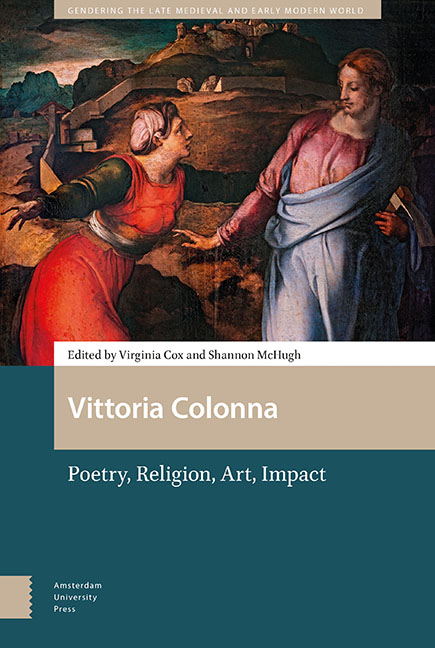40 results
Dedication
-
- Book:
- Vittoria Colonna
- Published by:
- Amsterdam University Press
- Published online:
- 16 December 2021
- Print publication:
- 06 November 2021, pp 5-6
-
- Chapter
- Export citation
Part 1 - Literary and Spiritual Sociability
-
- Book:
- Vittoria Colonna
- Published by:
- Amsterdam University Press
- Published online:
- 16 December 2021
- Print publication:
- 06 November 2021, pp 35-36
-
- Chapter
- Export citation
List of Illustrations
-
- Book:
- Vittoria Colonna
- Published by:
- Amsterdam University Press
- Published online:
- 16 December 2021
- Print publication:
- 06 November 2021, pp 11-14
-
- Chapter
- Export citation
Contents
-
- Book:
- Vittoria Colonna
- Published by:
- Amsterdam University Press
- Published online:
- 16 December 2021
- Print publication:
- 06 November 2021, pp 7-10
-
- Chapter
- Export citation
Part 4 - Art
-
- Book:
- Vittoria Colonna
- Published by:
- Amsterdam University Press
- Published online:
- 16 December 2021
- Print publication:
- 06 November 2021, pp 171-172
-
- Chapter
- Export citation
Volume Bibliography
-
- Book:
- Vittoria Colonna
- Published by:
- Amsterdam University Press
- Published online:
- 16 December 2021
- Print publication:
- 06 November 2021, pp 371-398
-
- Chapter
- Export citation

Vittoria Colonna
- Poetry, Religion, Art, Impact
-
- Published by:
- Amsterdam University Press
- Published online:
- 16 December 2021
- Print publication:
- 06 November 2021
Thematic Index
-
- Book:
- Vittoria Colonna
- Published by:
- Amsterdam University Press
- Published online:
- 16 December 2021
- Print publication:
- 06 November 2021, pp 401-406
-
- Chapter
- Export citation
Index of Citations of Colonna’s Letters and Verse
-
- Book:
- Vittoria Colonna
- Published by:
- Amsterdam University Press
- Published online:
- 16 December 2021
- Print publication:
- 06 November 2021, pp 399-400
-
- Chapter
- Export citation
Part 2 - Widowhood
-
- Book:
- Vittoria Colonna
- Published by:
- Amsterdam University Press
- Published online:
- 16 December 2021
- Print publication:
- 06 November 2021, pp 73-74
-
- Chapter
- Export citation
Frontmatter
-
- Book:
- Vittoria Colonna
- Published by:
- Amsterdam University Press
- Published online:
- 16 December 2021
- Print publication:
- 06 November 2021, pp 1-4
-
- Chapter
- Export citation
Part 5 - Readership
-
- Book:
- Vittoria Colonna
- Published by:
- Amsterdam University Press
- Published online:
- 16 December 2021
- Print publication:
- 06 November 2021, pp 271-272
-
- Chapter
- Export citation
Part 3 - Poetry
-
- Book:
- Vittoria Colonna
- Published by:
- Amsterdam University Press
- Published online:
- 16 December 2021
- Print publication:
- 06 November 2021, pp 115-116
-
- Chapter
- Export citation
Acknowledgements
-
- Book:
- Vittoria Colonna
- Published by:
- Amsterdam University Press
- Published online:
- 16 December 2021
- Print publication:
- 06 November 2021, pp 15-16
-
- Chapter
- Export citation
Part 6 - Impact
-
- Book:
- Vittoria Colonna
- Published by:
- Amsterdam University Press
- Published online:
- 16 December 2021
- Print publication:
- 06 November 2021, pp 307-308
-
- Chapter
- Export citation
Introduction: The Twenty-First Century Vittoria Colonna
-
-
- Book:
- Vittoria Colonna
- Published by:
- Amsterdam University Press
- Published online:
- 16 December 2021
- Print publication:
- 06 November 2021, pp 17-34
-
- Chapter
- Export citation
An Unknown Early Modern New World Epic: Girolamo Vecchietti’s Delle prodezze di Ferrante Cortese (1587–88)
-
- Journal:
- Renaissance Quarterly / Volume 71 / Issue 4 / Winter 2018
- Published online by Cambridge University Press:
- 14 January 2019, pp. 1351-1390
- Print publication:
- Winter 2018
-
- Article
- Export citation
Chapter 17 - Dialogue
- from Part III - Prose
-
-
- Book:
- A Guide to Neo-Latin Literature
- Published online:
- 02 March 2017
- Print publication:
- 16 January 2017, pp 289-307
-
- Chapter
- Export citation
11 - Rhetoric and ethics in Machiavelli
-
-
- Book:
- The Cambridge Companion to Machiavelli
- Published online:
- 28 September 2010
- Print publication:
- 24 June 2010, pp 173-189
-
- Chapter
- Export citation
Gender and Eloquence in Ercole de' Roberti's Portia and Brutus
-
- Journal:
- Renaissance Quarterly / Volume 62 / Issue 1 / Spring 2009
- Published online by Cambridge University Press:
- 20 November 2018, pp. 61-101
- Print publication:
- Spring 2009
-
- Article
- Export citation



